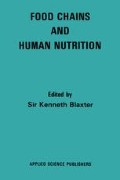Abstract
Minerals form an essential part of all living matter, and more than thirty of them have been incorporated into animal bodies, including the body of man. Some have known functions, others not, and their presence may be only fortuitous. Sometimes the same element has been used to fulfil many functions, sometimes the same function is served by two or more elements. Some are present in the adult human body to the tune of hundreds of grams, others are there in the merest traces. We are concerned with the major elements, which include the electrolytes, sodium, potassium, and chloride, and the bone minerals calcium, phosphorus and also magnesium. Table 1 shows the approximate amounts of these elements in the body of a man. Calcium is the most plentiful, followed by phosphorus. There is more potassium than sodium on a weight basis, but more sodium than potassium in molar terms.
Access this chapter
Tax calculation will be finalised at checkout
Purchases are for personal use only
Preview
Unable to display preview. Download preview PDF.
References
Bell, F. R. and Sly, J. (1976). The assessment of sodium appetite in calves using operant conditioning procedures, J. Physiol., Lond., 263, 178–9.
Card, W. J. and Marks, I. N. (1958). A case of magnesium deficiency, in Water and Electrolyte Metabolism in relation to Age and Sex (Eds. G. E. Wolstenholme and M. O’Connor ), Ciba Foundation Colloquium on Ageing, Churchill, London, 4, pp. 301–8.
Department of Health and Social Security (1969). Recommended Intakes of Nutrients for the United Kingdom, Reports on Public Health and Medical Subjects, No. 120, HMSO, London.
Ehrstrom, R. (1934). Die Diät-und Kostführung der nordischen Länder in historischer Beleuchtung, Acta Med. Scand., 81, 583.
Exton-Smith, A. N., Millard, P. H., Payne, R. R. and Wheeler, E. F. (1969). Pattern of development and loss of bone with age, Lancet, 2, 1154.
Gabriel, S. (1894). Chemische Untersuchungen über die Mineralstoffe der Knochen und Zähne, Z. Physiol. Chem., 18, 257.
McCance, R. A., Ungley, C. C., Crosfill, J. W. L. and Widdowson, E. M. (1956). The Hazards to Men in Ships Lost at Sea 1940–44, Spec. Rep. Ser. Med. Res. Coun. No. 291, HMSO, London.
McCance, R. A. and Widdowson, E. M. (1935). Phytin in human nutrition, Biochem. J., 29, 2694.
McCance, R. A., Widdowson, E. M. and Shackleton, L. R. B. (1936). The Nutritive Value of Fruits, Vegetables and Nuts, Spec. Rep. Ser. Med. Res. Coun. No. 213, HMSO, London.
McLean, F. C. and Urist, M. R. (1955). Bone, University of Chicago Press, Chicago, I II.
Ministry of Agriculture, Fisheries and Food (1978). Household Food Consumption and Expenditure 1977, HMSO, London.
Moss, K. N. (1923–24). Some effects of high air temperatures and muscular exertion upon colliers, Proc. Roy. Soc., Lond.,B95,181.
National Research Council (1974). Recommended Dietary Allowances, 8th ed., National Academy of Sciences, Washington DC.
Paul, A. A. and Southgate, D. A. T. (1978). McCance and Widdowson’s The Composition of Foods, 4th revised ed. of Spec. Rep. Ser. Med. Res. Coun. No. 297, HMSO, London.
Scott, P. P., Greaves, J. P. and Scott, M. G. (1961). Nutrition of the cat. 4. Calcium and iodine deficiency on a meat diet, Brit. J. Nutr., 15, 35.
Widdowson, E. M. and Dickerson, J. W. T. (1964). Chemical composition of the body, in Mineral Metabolism (Eds. C. L. Comar and F. Bronner ), Academic Press, New York, 2A, pp. 1–247.
Author information
Authors and Affiliations
Editor information
Editors and Affiliations
Rights and permissions
Copyright information
© 1980 Applied Science Publishers Ltd
About this chapter
Cite this chapter
Widdowson, E.M. (1980). Man and the Major Mineral Elements. In: Blaxter, K. (eds) Food Chains and Human Nutrition. Springer, Dordrecht. https://doi.org/10.1007/978-94-011-7336-0_9
Download citation
DOI: https://doi.org/10.1007/978-94-011-7336-0_9
Publisher Name: Springer, Dordrecht
Print ISBN: 978-94-011-7338-4
Online ISBN: 978-94-011-7336-0
eBook Packages: Springer Book Archive

